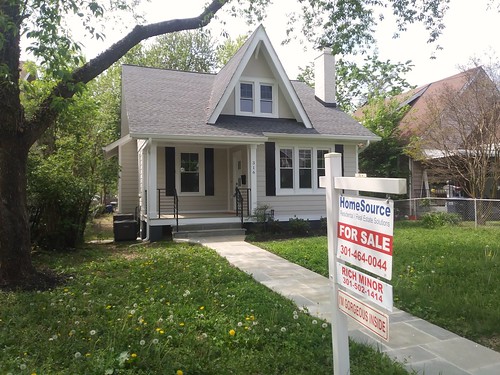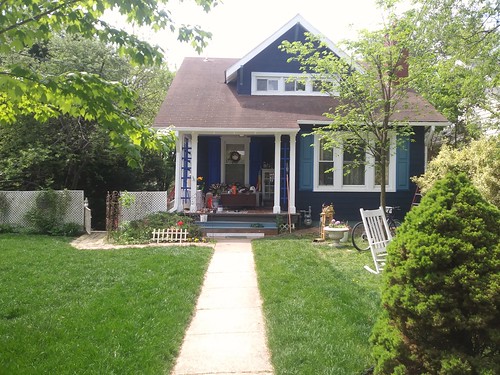House flipping as reproduction of space
Space and how it is used never remains static, even if it can appear to be so over long periods of time.
Flipping as a production system. There was an article in the Post real estate section last weekend about flipping and the "we buy houses" segment of the market.
According to the article, "Tired of the hassle of selling your home? Try this all-cash alternative," these companies pay 25% to 40% below the market value, but getting paid quickly appeals to a certain segment of the market.
Now instead of this being a small firm phenomenon which is usually how it works at the sub-district and neighborhood scale--e.g., a guy flipped a house on our block--did a great job, even if not every choice appealed to me--and then did another and is working on yet another on the next block--firms are now starting to do this if not on a national footprint, at least in multiple strong markets where the returns are especially high.
While flipping is nothing new ("Flip Service: Local Company Flips 80 Homes in 2008, Projects 130 in 2009," Washington City Paper), because the area housing market is so out of whack in terms of supply and demand, these days it is highly profitable, especially as homes owned by aging households come onto the market needing a lot of work.
Flipping as refreshing a tired space. The thing about "house flipping" -- buying an old house and "fixing it up" -- if done right it is a vital and necessary part of the housing maintenance and production process, because after a few decades of use, houses tend to need to be "refreshed."
 By that I don't mean a complete gut job and open concept reconfiguration a la the Fixer Upper tv show. Or the houses featured in local newspaper real estate sections...
By that I don't mean a complete gut job and open concept reconfiguration a la the Fixer Upper tv show. Or the houses featured in local newspaper real estate sections...Open concept removes interior walls separating, living, dining, and kitchen spaces.
But after a few decades, a house tends to need a fair amount of repair and renovation work, including:
- windows (not replacements, repairs)
- new roof shingles
- updating mechanical systems
- maybe some interior reconfiguration
- new appliances (our stove is 80 years old and works fine, our kitchen sink is 90 years old and we love it, our washer is 40+ years old and the repairman was adamant that we replace the still original fill hoses, etc.)
- maybe some strategic additions
- adding a bathroom
- attic or basement renovations
- cosmetic improvements like painting inside and outside
- yard work and landscaping
- etc.
What the report, House Flipping in NYC: How Real Estate Speculators Are Targeting New York City's Most Affordable Neighborhoods, from the Center for NYC Neighborhoods describes as happening in NYC is the same process that is occurring in other high demand cities--DC, Seattle, Boston, etc. And it's what's happening in my own neighborhood.
It's a systematic acquisition of properties, fixing them up, and selling them for close to double the price that they paid for the house. Although again I will say that in the current go around, the firms I'm seeing do this are doing decent work, not crap (cf. "Flipped Off: In D.C.’s Thriving Market For Renovated Homes, It’s Buyer Beware," WAMU/NPR). And they are investing a fair amount of time and money in the projects, unlike the paint and resell efforts that typified things before 2009.
E.g., now the prices for renovated houses in our neighborhood are between $800,000 and $900,000,which is a more than doubling of what the houses cost ten years ago.
Interestingly, a house last year was marketed as in need of a gut job at $475,000 but the people who bought it did just a few changes and "got it at a good price."
Because our property "lags the market" in terms of not being fully renovated, we get letters and postcards every week, and the occasional phone call, from flippers looking to buy our house cheap and sell it expensively.
That might mean $100,000 to $200,000 in renovations, but still gives them a great profit, especially as housing supply remains low and demand high.
Historic preservation and affordable housing. But before the "revalorization process" this kind of housing made up the predominant chunk of what we would call "naturally occurring affordable housing," the kind of housing that Donovan Rypkema wrote about many years ago in terms of historic preservation being simultaneously a housing affordability strategy.
-- Historic Preservation and Affordable Housing: The Missed Connection, National Trust for Historic Preservation, 2002
As discussed in the past, it's easy for this type of housing to remain affordable when the real estate market is weak either at the city, county, or neighborhood scale. When it's in demand, historic preservation contributes to housing unaffordability, but that being said also contributes to center city and neighborhood success, by keeping neighborhoods and communities relevant in the context of the metropolitan residential real estate market.
The flipping process and building neighborhood confidence. Building Neighborhood Confidence is the title of a book by Rolf Goetze, published in the early 1970s, which discussed the process of neighborhood decline and a way to reverse it, by providing initial public support and investment in improvements, with the aim of sparking people's willingness and commitment to once again reinvesting in their communities.
Pre-renovation.
Interestingly, as some of these houses are getting flipped and improved on my street--these particular houses had long gone into decline, or had been vacant for many years and were unkempt and overgrown, it's spurring complementary investments by residents who aren't interested in selling or moving, but staying.
It was pretty typical to see houses that we didn't realize had side porches because the vegetation had completely overgrown the house, etc.

The same house after renovation.
An old joke, c. 2001. I was active on the Columbia_heights e-list, which was one of the earliest neighborhood listservs. Someone wrote an email to the list, stating that they wanted to buy a "fixer upper" -- a house, because it needs work, can be bought at a price lower than what would be market value.
The reply said "just look for a house being marketed as 'recently renovated'" [because you know it's going to need to be fixed up after a bad renovation].
This is the house next door. They've resodded more than half the front yard and are now in the process of repainting the exterior, including a new scheme for the trim. I don't know if they're doing interior renovations, but it's an example of how a house redo elsewhere on a block can spur complementary investments by other residents.

Labels: affordable housing, housing market, neighborhood revitalization, real estate development, urban revitalization






0 Comments:
Post a Comment
<< Home